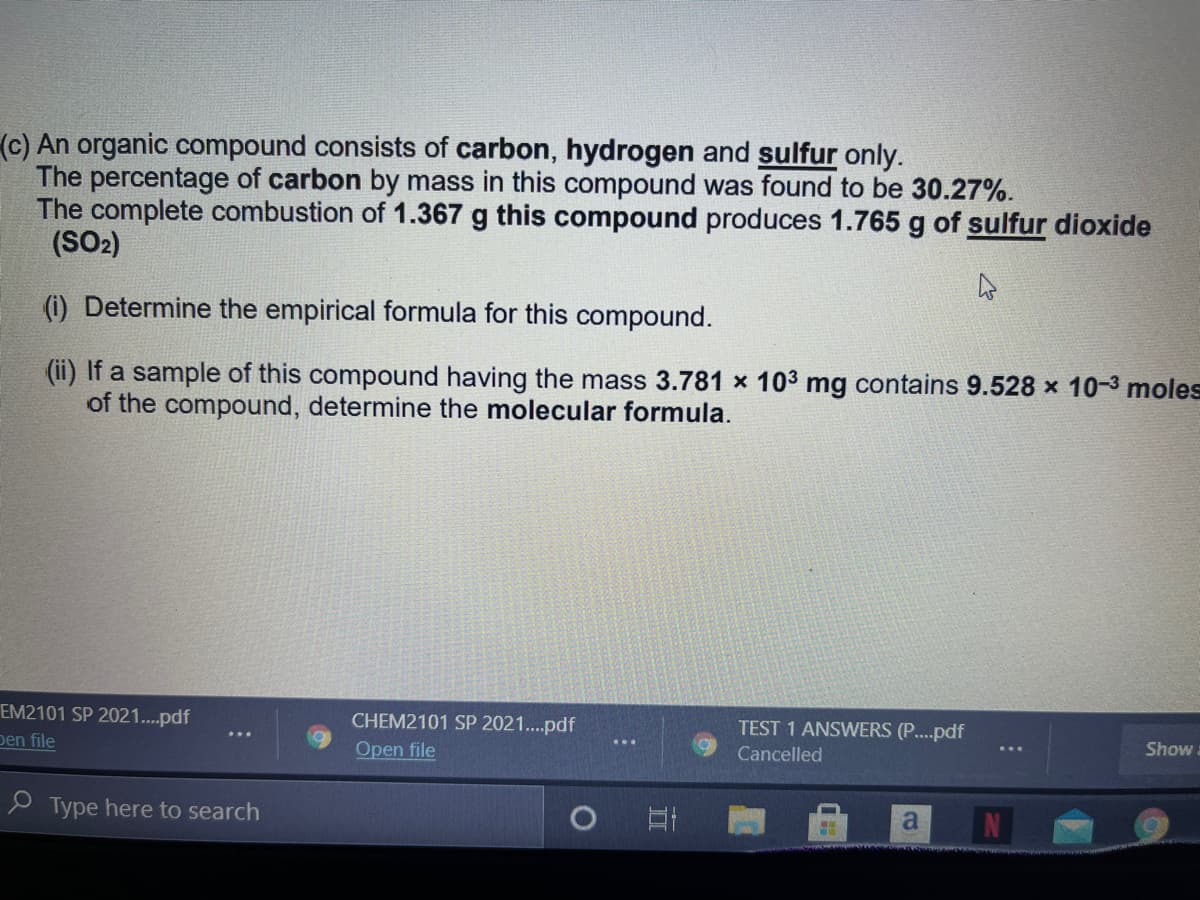c) An organic compound consists of carbon, hydrogen and sulfur only. The percentage of carbon by mass in this compound was found to be 30.27%. The complete combustion of 1.367 g this compound produces 1.765 g of sulfur dioxide (SO2) (i) Determine the empirical formula for this compound. (ii) If a sample of this compound having the mass 3.781 x 103 mg contains 9.528 x 10-3 moles of the compound, determine the molecular formula.
c) An organic compound consists of carbon, hydrogen and sulfur only. The percentage of carbon by mass in this compound was found to be 30.27%. The complete combustion of 1.367 g this compound produces 1.765 g of sulfur dioxide (SO2) (i) Determine the empirical formula for this compound. (ii) If a sample of this compound having the mass 3.781 x 103 mg contains 9.528 x 10-3 moles of the compound, determine the molecular formula.
Chemistry & Chemical Reactivity
10th Edition
ISBN:9781337399074
Author:John C. Kotz, Paul M. Treichel, John Townsend, David Treichel
Publisher:John C. Kotz, Paul M. Treichel, John Townsend, David Treichel
Chapter2: Atoms Molecules And Ions
Section2.8: Instrumental Analysis: Determining Compound Formulas
Problem 2.2ACP: Salvarsan was long thought to be a single substance. Recently, however, a mass spectrometry study of...
Related questions
Question

Transcribed Image Text:(c) An organic compound consists of carbon, hydrogen and sulfur only.
The percentage of carbon by mass in this compound was found to be 30.27%.
The complete combustion of 1.367 g this compound produces 1.765 g of sulfur dioxide
(SO2)
(i) Determine the empirical formula for this compound.
(ii) If a sample of this compound having the mass 3.781 x 103 mg contains 9.528 x 10-3 moles
of the compound, determine the molecular formula.
EM2101 SP 2021..pdf
CHEM2101 SP 2021..pdf
TEST 1 ANSWERS (P..pdf
Show.
pen file
Open file
Cancelled
P Type here to search
Expert Solution
This question has been solved!
Explore an expertly crafted, step-by-step solution for a thorough understanding of key concepts.
Step by step
Solved in 4 steps

Knowledge Booster
Learn more about
Need a deep-dive on the concept behind this application? Look no further. Learn more about this topic, chemistry and related others by exploring similar questions and additional content below.Recommended textbooks for you

Chemistry & Chemical Reactivity
Chemistry
ISBN:
9781337399074
Author:
John C. Kotz, Paul M. Treichel, John Townsend, David Treichel
Publisher:
Cengage Learning

Chemistry: An Atoms First Approach
Chemistry
ISBN:
9781305079243
Author:
Steven S. Zumdahl, Susan A. Zumdahl
Publisher:
Cengage Learning


Chemistry & Chemical Reactivity
Chemistry
ISBN:
9781337399074
Author:
John C. Kotz, Paul M. Treichel, John Townsend, David Treichel
Publisher:
Cengage Learning

Chemistry: An Atoms First Approach
Chemistry
ISBN:
9781305079243
Author:
Steven S. Zumdahl, Susan A. Zumdahl
Publisher:
Cengage Learning


Chemistry
Chemistry
ISBN:
9781305957404
Author:
Steven S. Zumdahl, Susan A. Zumdahl, Donald J. DeCoste
Publisher:
Cengage Learning

Chemistry: The Molecular Science
Chemistry
ISBN:
9781285199047
Author:
John W. Moore, Conrad L. Stanitski
Publisher:
Cengage Learning

Chemistry: Principles and Practice
Chemistry
ISBN:
9780534420123
Author:
Daniel L. Reger, Scott R. Goode, David W. Ball, Edward Mercer
Publisher:
Cengage Learning